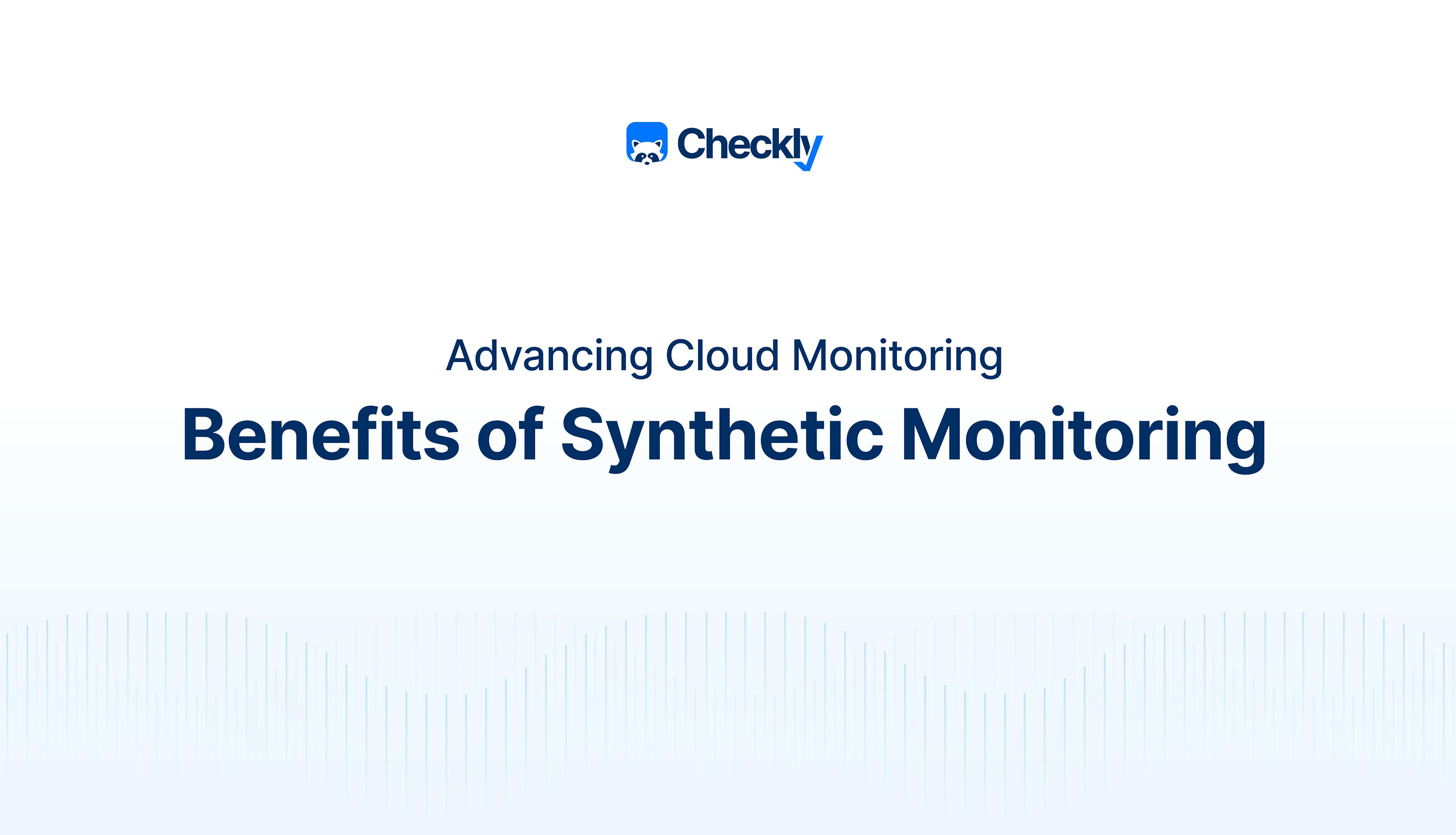Table of contents
The cloud changed how businesses work, making things more flexible and adaptable. But keeping track of app performance from a user’s point of view in this new setup is tough. Legacy tools tend to not give developers an understanding of their users' perspective.
That's where synthetic monitoring comes in. It's a strong way to focus on users and fix the problems that legacy tools miss.
In this article, we’ll take a look at the limitations of traditional monitoring approaches and how synthetic monitoring fills the gaps. Moreover, we’ll walk you through the top benefits of synthetic monitoring through some common use cases.
The Limitations of Traditional Monitoring Approaches
Traditional monitoring tools tend to concentrate mainly on infrastructure metrics, like CPU usage, network latency, or server health. These metrics are necessary for knowing the state of the underlying infrastructure, but they do not provide insight into the end-user experience or the performance of applications from the user's point of view.
As a result, traditional tools can fail to identify problems that have an immediate effect on users, like sluggish webpage loads, errors during particular user interactions, or challenges navigating the application.
IT operations teams struggle to maintain service quality when applying legacy monitoring approaches to digital services in the cloud. - Gartner Report, 3 Ways to Optimize Observability and Monitoring of Digital Services in the Cloud
Synthetic monitoring, on the other hand, gets beyond these constraints by actively modeling user interactions and workflows. By simulating the activities of actual users, it examines apps and offers insights into the genuine user experience.
Synthetic monitoring provides a more thorough perspective that is in line with the user's experience by testing the application's features, load times, and overall performance. This methodology aids in the detection and resolution of issues that impact users before they have a wider impact, thereby enhancing the application's overall quality and dependability.
With businesses increasingly embracing cloud-based structures and microservices, there's a growing necessity for a more sophisticated approach that comprehensively considers the end-to-end user experience and the intricate details of modern distributed systems.
Synthetic monitoring emerges as an invaluable solution by simulating user behaviors, providing real-time insights into application performance, and addressing the gaps that traditional monitoring tools fail to cover. This approach ensures a more holistic and user-centric monitoring methodology, aligning better with the complexities of modern IT landscapes and user expectations.
What is Synthetic Monitoring?
Synthetic monitoring involves the use of scripted user journeys that are replayed from multiple locations to emulate real-world user interactions with your application. These journeys can range from navigating to a web application to ensure availability, to testing an entire purchase flow, from searching and selecting a product to checking out and verifying the payment flow. Synthetic monitoring allows you to run and test your mission-critical user flows in high intervals and gain confidence that your applications and websites operate smoothly globally.
Find out more about the core concepts of synthetic monitoring.
If you’re more into video content, gain more insight into synthetic monitoring from our tutorial:
Why Do You Need Synthetic Monitoring: Top Benefits of Synthetic Monitoring
Now that we’ve seen the basics of synthetic monitoring, let’s explore some synthetic monitoring tools use cases that highlight the diverse advantages of incorporating synthetic monitoring into business operations:
1. Finding Isues Before They Impact Your Users
Synthetic monitoring tracks issues (performance monitoring, uptime monitoring, bugs, outages, etc.) in websites, applications, or APIs, promptly initiating incident management protocols and notifying designated team members upon issue identification. In fact, synthetic monitoring can help you reduce customer-reported issues by 95%.
Its continuous automated operation, running at intervals as short as every 30 seconds, facilitates immediate problem discovery, enabling teams to address issues proactively and potentially mitigating widespread user impact.
2. Testing from the User Perspective
Synthetic monitoring mimics real user behavior and interactions with the application and performs real user monitoring. This approach provides insights into the user experience, including load times, functionalities, and navigation.
This user-centric approach helps in identifying usability issues, optimizing functionalities, and ultimately enhancing the overall user experience. Through testing from the user perspective, organizations can proactively address issues before they impact real users, ensuring a more seamless and satisfactory experience for their audience.
3. Preparing for the Launch in New Markets
Businesses can reduce the risk of unexpected problems affecting users by optimizing their offerings prior to the official rollout by using a synthetic monitoring tool, which mimics user behavior, checks for bugs, and assesses the responsiveness of the system.
This proactive approach aids in the identification and resolution of any performance bottlenecks or errors, guaranteeing a smoother and more reliable experience for actual users once the new launch occurs.
Furthermore, synthetic monitoring offers valuable insights into how the application behaves in different geographical locations or when new features are introduced.
4. Monitoring Complex Processes
A synthetic monitoring system is excellent for overseeing complex operations because it can copy intricate user actions in apps or systems. It checks each step of the process by creating pretend user experiences, allowing continuous and thorough oversight. Companies can spot slowdowns, performance issues, or errors in these complex processes using this method.
By using synthetic browser and API monitoring, businesses gain a better understanding of how the system behaves in different situations, ensuring these complicated procedures run smoothly. It provides immediate insights, helping to spot and fix issues early, which improves the reliability and efficiency of these complex operations in the long run.
Here are some processes where synthetic monitoring would be the right choice:
E-commerce Checkout Process
Synthetic monitoring can simulate user interactions during the checkout process of an e-commerce website. It simulates steps like adding items to the cart, applying discounts, entering payment information, and finalizing the purchase.
By doing so, it identifies any performance bottlenecks or errors that might occur during this intricate process. For instance, it can detect delays in payment processing or errors in applying promotional codes, allowing businesses to fix these issues before real users experience them.
Thanks to synthetic monitoring, drivvn has reduced the time it takes them to detect issues by 75%.
“Within about 20 minutes of Checkly first detecting the issue, we identified where the problem was and had a fix ready to go. The ability to constantly see critical journeys on our site and to get notified when they fail has been invaluable to us. It’s been pretty transformational.”
Banking Transactions
In the banking sector, synthetic monitoring can replicate user actions involved in transferring funds between accounts or executing complex financial transactions. It imitates the steps users take when initiating transfers, verifying identities, and completing transactions.
This monitoring approach helps identify any glitches or delays in the transaction process, ensuring the smooth and secure operation of critical financial services.
Healthcare Systems and Patient Records
Synthetic monitoring can simulate interactions within healthcare systems, like accessing patient records, scheduling appointments, and updating medical information. It evaluates the performance of these processes and ensures that healthcare providers can efficiently access and manage patient data without encountering system slowdowns or errors.
Supply Chain Management
For companies managing complex supply chains, synthetic monitoring can simulate various steps in the supply chain process, such as order processing, inventory management, and logistics tracking. It helps detect any inefficiencies or errors that could disrupt the flow of goods, allowing businesses to optimize their supply chain operations.
5. Improving the Reliability of the Application
Not only does synthetic monitoring help the development and IT teams fix bugs and make the system run better, it also detects errors, slow response times, and downtime before they affect real users.
It also supports benchmarking and performance standard-setting, guaranteeing that the application consistently meets expected service levels.
Thanks to this continuous synthetic monitoring and prompt issue identification, businesses can improve the overall reliability of their applications and create a more stable and reliable user experience.
6. Immediately Getting Notified When Service is Unavailable
Getting instant warnings or notifications when an application or service goes down or is unavailable is one of the main advantages of synthetic monitoring. IT staff can respond quickly, reduce downtime, and ensure user service availability thanks to this early detection.
7. Testing New Product Features
Synthetic monitoring helps teams test controlled test environments that replicate actual user circumstances, enabling thorough assessment of the new features or products' performance under various circumstances. This approach offers information on the changes' usability, performance, and functionality prior to their formal public release.
These tests allow companies to find issues, see how the new components affect the system as a whole, and ensure that they work well with the existing features.
Synthetic monitoring makes it easier to find and fix any problems or faults before they happen. This lowers the risk of problems and makes the rollout of new products or services to customers go more smoothly.
Synthetic monitoring is particularly useful for SaaS applications, where traditional monitoring falls short due to the inability to place instrumentation within the application or hosting environment. It provides valuable insights into response times and network path conditions, which are critical for SaaS applications.
I&O leaders should ensure that all critical user journeys are covered by synthetic monitoring scenarios. - Gartner Report, 3 Ways to Optimize Observability and Monitoring of Digital Services in the Cloud
9. Bridging the Gap with Monitoring as Code
While synthetic monitoring offers a comprehensive approach, integrating it with a Monitoring as Code (MaC) framework like Checkly's can add an extra layer of agility and automation. Checkly's CLI allows you to code, test, and deploy your synthetic monitoring checks, aligning your monitoring practices with your agile development process.
10. Establishing a Common Language Across the Entire Business
One of the often-overlooked benefits of synthetic monitoring is its ability to establish a common language across IT and business teams. By focusing on user-centric metrics and KPIs, synthetic monitoring helps bridge the gap between technical and non-technical stakeholders, fostering better collaboration and decision-making.
Take Control of Your Cloud Monitoring
In the cloud era, synthetic monitoring is not just an option; it's a necessity. It provides the depth of insight required for comprehensive cloud monitoring and, when subtly integrated with Monitoring as Code, offers the agility needed in today's fast-paced, cloud-centric world. By adopting this approach, organizations are setting a new standard for operational excellence and user experience in the cloud.


